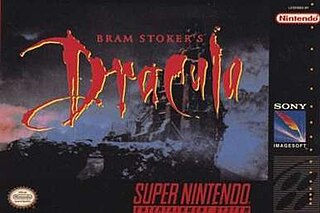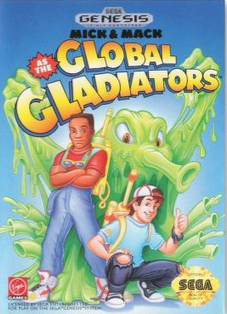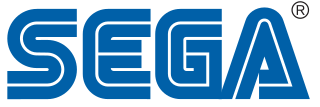
Sonic the Hedgehog is a 1991 side-scrolling platform game and companion to the 16-bit Sega Genesis game of the same name for the 8-bit Game Gear and Master System consoles. Ancient—a studio founded by composer Yuzo Koshiro for the project—developed the game and Sega published it to promote the handheld Game Gear. The 8-bit Sonic is similar in style to its Genesis predecessor, but reduced in complexity to fit the 8-bit systems. It was released for the Game Gear on December 28, 1991, and for the Master System around the same time. It was later released through Sonic game compilations and Nintendo's Virtual Console.

Alien Syndrome is a run & gun shooter arcade game developed by Sega and released in 1987.

Batman Returns is a beat 'em up video game for various platforms based on the film of the same name. The Sega console versions were published by Sega while the NES and Super NES versions were developed and published by Konami. The MS-DOS version was published by Konami and developed by Spirit of Discovery. The Amiga version was developed by Denton Designs, and also published by Konami. There is also a Lynx version, published by Atari Corporation.

Dynamite Headdy is a platform video game developed by Treasure and published by Sega for the Sega Genesis in 1994. The game follows a puppet named Headdy in his efforts to stop an evil puppet king from taking over his world. Headdy can throw his head at enemies to defeat them and use it to pull himself to various areas and move objects. The player can find a wide variety of "heads" which act as power-ups that provide different effects and alter gameplay.

Castle of Illusion Starring Mickey Mouse is a 1990 platform game developed by Sega and released for the Sega Genesis. An 8-bit version of the game was later released for the Master System and Game Gear. The game follows Mickey Mouse on a quest to save Minnie Mouse from the evil witch Mizrabel. It was the first game in Sega's long-running Illusion video game series starring Mickey and was also a part of the second wave of games initially released for the Sega Genesis which helped seal the console's reputation within the period until the release of Sonic the Hedgehog in 1991.

Bram Stoker's Dracula is a 1993 video game released for the Nintendo Entertainment System, Super NES, Game Boy, Master System, Genesis, Sega CD, Game Gear, MS-DOS and Amiga games consoles. Based on the 1992 movie of the same name which in turn is based on the 1897 novel by Bram Stoker, each version of the game was essentially identical. The Amiga version was released in 1994 for North America and Europe. A CD-ROM version for DOS was released in 1995.

Sonic the Hedgehog 2 is a platform game developed by Aspect and published by Sega for the Master System and Game Gear. The Master System version was released in Europe on October 1992. The Game Gear version was released first in Europe in October 1992, and in North America and Japan in the following month. It's a sequel to Sonic the Hedgehog for Master System and Game Gear.

There have been several video games based on the 1991 film Hook. A side-scrolling platform game for the Nintendo Entertainment System (NES) and Game Boy was released in the United States in February 1992. Subsequent side-scrolling platform games were released for the Commodore 64 and the Super Nintendo Entertainment System (SNES) later in 1992, followed by versions for the Sega CD, Sega Genesis, and Sega's handheld Game Gear console in 1993. An arcade game was also released in 1993.

Global Gladiators is a 1992 platform game published and developed by Virgin Games, originally programmed by David Perry for the Mega Drive/Genesis and eventually ported by other Virgin Games teams in Europe to the Master System, Game Gear and the Amiga. A Super NES and an NES port were also in development but were never completed for undisclosed reasons, though a ROM image has since surfaced. The game is based on the McDonald's fast food chain and has a strong environmentalist message.

Alien 3 is a platform video game based on the 1992 film of the same name. The game was released for the Sega Genesis and Amiga in 1992. Additional versions were released in 1993, for the Commodore 64, Game Boy, Game Gear, Nintendo Entertainment System (NES), Super Nintendo Entertainment System (SNES), and Master System.

Wonder Boy is a 1986 platformer video game published by Sega and developed by Escape.

The Adventures of Batman & Robin is a series of video game adaptations released between 1994 and 1995 featuring the DC Comics characters Batman and Robin based on Batman: The Animated Series. The games were released for numerous platforms, with the Genesis, Game Gear, and Sega CD versions published by Sega while the Super NES version was published by Konami.

The Addams Family is a platform game based on the 1991 movie of the same name released by Ocean Software in 1992. The game was released for the Master System, TurboGrafx-16, Sega Mega Drive/Genesis, Super NES, Amiga and Atari ST.

Disney's Ariel the Little Mermaid, usually shorted to simply Ariel the Little Mermaid, is a 1992 video game developed by Blue Sky Software for the Sega Genesis, Game Gear and Master System, based on the 1989 film The Little Mermaid.

Land of Illusion Starring Mickey Mouse, released in Japan as Mickey Mouse no Mahō no Crystal (ミッキーマウスの魔法のクリスタル), and in Brazil as Land of Illusion Estrelando Mickey Mouse, is a platform game developed and published by Sega for the Master System and Game Gear.

Home Alone is the title of several tie-in video games based on the film of the same name. Versions were released for the Nintendo Entertainment System, Game Boy, Super NES, Master System, Genesis, Game Gear, Amiga and MS-DOS platforms.

Ninja Gaiden is a side-scrolling, hack & slash, platform-action video game developed by SIMS and released by Sega for the Master System in 1992, with license from Tecmo.

The Lucky Dime Caper starring Donald Duck, released in Japan as Donald Duck no Lucky Dime (ドナルドダックのラッキーダイム), is a platform game released for Master System and Game Gear in 1991. It features Donald Duck as the main character. Working titles for the game were "Duck Tales" and "Donald Duck". A sequel to Lucky Dime Caper, Deep Duck Trouble, also featuring Donald Duck, was released for Master System and Game Gear in 1993.





















